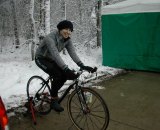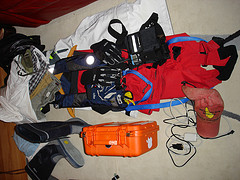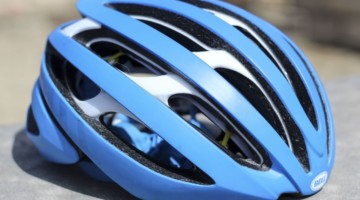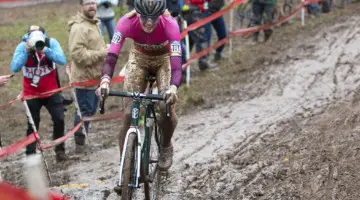
Get in your warm up! Genevieve Whitson warming up at the 2010 Belgian World Cross Cup. Photo Courtesy of Genevieve Whitson
In the just-released Issue 14, our regular contributors all chipped in with advice for a piece on 25 Things to Do on Raceday (and Robbie Carver threw in his own, more lighthearted, race essentials list, which included such things as pre-vomiting). Now Rhonda Morin, Cat 1 ’crosser, Masters Nationals bronze medalist and coach with Wenzel Coaching, adds her own call for preparedness and contributes a couple of valuable lists of her own below–perfect for the newbies and experts alike.
by Rhonda Morin, EMT
Preparation prevents poor performance. The more you can convert your race prep into routines, and the more you can take care of in the days before an event, the less stress you’ll have in the final hours before the race and the better you’ll perform. This article provides tips on what you can do to prepare for the race before you get to the venue, thereby freeing your mind so you can concentrate on having an excellent race.
Cleaning your bike after each race cuts down on wear and tear on your bike, provides an opportunity to identify and correct mechanical problems and also eliminates one more thing to do the day before the next race. I’m usually still in race mode when I get home after an event, so after I’ve had my recovery meal and a bit of relaxation time with my legs up to jump-start my recovery, I make it a point to put my bike on the stand and begin cleaning.
Using a mild soap – such as dish soap – in a bucket of warm water, I use a soft bristle brush, like one you would wash your car with, for my frame and wheels, and a separate brush for the greasy stuff, like the chain and drive train. Don’t use the same brush on the wheels as you would for the chain, because greasy wheels will break down the rubber on your brake pads and make your rims slippery. As a general rule, it is best to keep brushes and rags separate. Keep a grease rag/brush container, and a non-grease container in your garage or workspace.
Make sure grit, sand and mud are removed from your chain, drive train, pulleys and cassette. Do this with a rag and/or a stiff brush such as a Park Tool Gear Cleaning Brush. This will ensure that you will start your next race with a smooth sounding chain and not one that’s crunchy. Once the chain is cleaned, apply a lube that is specific for the sorts of conditions in which you race, and wipe off the excess. Also, wipe off the brake pads and rims. Use a toothbrush to reach the grooves in the brake pads. Get into the habit of at least doing these steps after each race and your bike will perform much better.
The day before the race is the time to pack your bag. I generally keep a ready-go bag packed all the time, which saves time and keeps me from forgetting important articles of clothing.
Ready-go bag
- Socks: tall socks or thermal socks for cool weather
- Knee warmers
- Leg warmers
- Arm warmers
- Vest, Racing jersey, and shorts or skinsuit
- Full-length tights
- Short-sleeve or long-sleeve undershirt
- Booties or thermal shoe covers
- Wind shoe covers
- Rain jacket & pants
- Team jacket
- Three kinds of gloves (so you can decide which to use when you get to the venue). These can include: fingerless gloves, thin gloves for mild weather, thermal gloves for cold.
- Cycling cap that fits under a helmet
- Towels
- Wash wipes
- Energy gels & bars (3 or 4 of each)
- Electrolyte tablets for bottles (Nuun, Hammer Fizz)
- Embrocation
- Racing license
- Pre-filled-out rider release form
- Safety pins
- Race number (previously pinned to jersey/skinsuit, if available)
- Plastic trash bags (for muddy, wet clothes)
- Toilet paper
Day Before Packing
The day before the race, I do a head-to-toe check. Starting with my head, I make sure these items are in my bag: helmet, sun glasses, headband or hat, undershirt, racing jersey and shorts or skinsuit, arm and leg warmers, socks and cycling shoes. Then I also pack post-race casual clothing and podium wear – because I’m always hopeful.
The night before the event, I’ll make lunch and prepare the dry ingredients for the bottles and recovery drink. I generally don’t fill the bottles until the morning, because I find the taste of plastic is too strong if they set overnight.
The bike usually goes into the car the night before, as well as several other items.
The List
- Racing glasses with lens options
- Heart rate monitor
- Bike pump
- Extra wheels or pit bike
- Tool box
- Tubes
- Foldable chair
- Square of flat foam or faux grass (to stand on while changing clothes)
- Umbrella
- Bucket with a brush, chain lube and rags
- Trainer or rollers
- iPod
- Cell phone
- Race flyer and directions
- Money: cash, or check (most races don’t take credit cards)
Day of Must Have
Now that I’m mostly packed, there is only the anxiety of the race to worry about. Get up in plenty of time to eat a regular breakfast anywhere from 30 minutes to three hours before your race. You’re less apt to have stomach distress when your stomach is empty while racing. But you’ll have to experiment with this one to see what works best for you.
Race day is not the day to try something new. Eat what you normally would, such as eggs, toast, juice; oatmeal and a banana; or cereal. Drink your coffee or tea if that’s your normal routine, but just be aware that coffee and tea are diuretics and may cause you to have to stop at the bathroom once or twice on the way to the race or at the race venue. Drink water during breakfast and pack a gallon of water for the day, as well as a bottle to sip on during the drive. It only makes a small difference, but avoid eating or drinking sweet, high-glycemic stuff during breakfast or before you warm up. In a sport where seconds can matter, small differences can be important.
Fill your race bottles and recovery drink bottle, put your lunch on an ice pack in a lunch pail, and head to your car. Before you drive off do one more head-to-toe check. Helmet, glasses, jersey shorts, shoes … if you have them all, you are ready to go.
Make it a point to stop and use the restroom at a restaurant or gas station before you get to the venue. The lines will be much shorter, saving valuable time for reconnoitering the course and warming up.
It’s best to arrive at the venue at least two hours in advance of your race in order to have time to get your number or register, pin the number on your jersey (which always takes longer than you think), get your pit wheels or bike into the pit, talk with your friends or teammates (which can also consume a lot of time), and wait in line at the Honey Buckets. Plan accordingly, and assume driving will take a bit longer than you expect. Your buddy may need an extra coffee stop, the lights may all be red, and road construction could be out in force.
If the course is open for a pre-ride, take an easy lap first so you can see where the tricky parts are and get a sense of what tire pressure is best, then do one or two more laps, with the last one being at race pace or just under, so you can get a sense of how you’ll respond to the course.
If you can’t get onto the course, walk some of it and watch how others handle a barrier or tricky corner and decide which lines look best.
Return to your bike and do your warm up on the trainer if you didn’t get to ride the course. Try to shoot for at least 40 minutes to 60 minutes of warm up, finishing with some short bursts of race-pace effort – this is another reason why you want to get to the venue two hours before, so you get a proper warm up. If you’re a Wenzel client, you should use the Super Warm Up. Be drinking fluids the whole time, switching from water to exercise drink after about 20 minutes of riding. Try to drink at least a bottle between arrival and racing.
Once warmed up, change out of your sweaty clothes and into a race jersey and warm jacket. Eat a GU or something with simple sugars in it to give you a boost, drink one last gulp and head to the start with 10 to 15 minutes to go so you get a good position.
Keep your jacket on while you wait at the start line. There’s plenty of time during the call-up to get to your start position and then throw your jacket to the side or pass it to a spectator. I sometimes wear an old jacket to the line that I don’t care much about in case I can’t find it later. But generally, people will leave your stuff alone and you can grab it after your race.
Now that you’re fueled and you’ve kept your morning-of packing preparations to a minimum, you are ready to have the best race of your season. Now go have some fun.
Rhonda Morin, EMT, is a Wenzel coach who specializes in helping people excel at cyclocross and long- distance running. She’s a Cat 1 cyclocross rider and national bronze medalist in the Master’s women’s category who has more than 20 years experience in competitive cycling and running. She can be reached at [email protected]



























